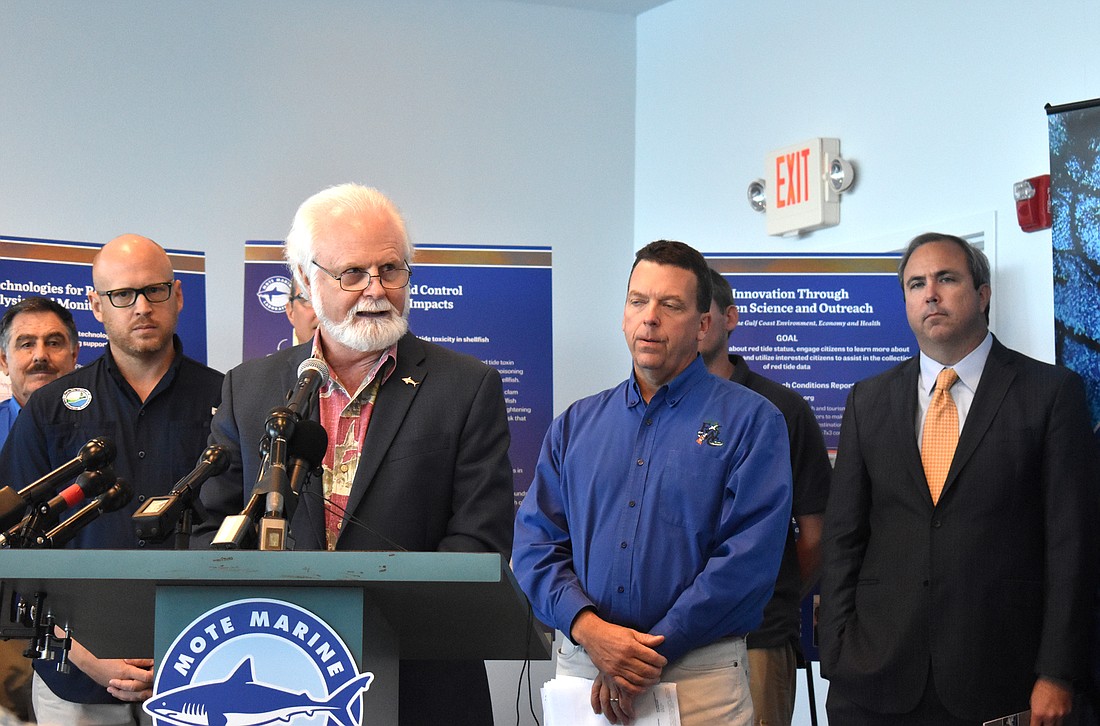- July 26, 2024
-
-
Loading

Loading

The state has granted nearly $2.2 million to Mote Marine Laboratory to expand testing and researching of red tide.
An announcement Monday at Mote Marine Laboratory brought experts from Mote, Florida Fish and Wildlife Conservation Commission, Florida Department of Environmental Protection and the Florida Department of Health together to discuss the investment.
FWC Executive Director Eric Sutton said the money will allow for innovative research technologies to be tested in the field.
“We’re building on that incredible productivity of research to now be able to launch an additional initiative that is going to focus on applied science and technology that is going to help us in fact attack red tide and decrease the impact that their harmful algal blooms have on our ecosystem, our quality of life and our economy,” Mote President and CEO Michael Crosby said.
The state will direct $2,178,000 to Mote to test technologies, such as Mote’s ozone treatment system and clay field testing, to mitigate the effects of red tide, a release from the governor’s office said.
Last week, Gov. Rick Scott announced a partnership between Mote, FWC, Woods Hole Oceanographic Institution, the University of South Florida and the Florida Department of Environmental Protection to focus on using specialized clay to suppress red tide’s effects, the statement said.
“For the very first time, the state of Florida is launching an initiative to not just monitor and do research on red tide,” Crosby said. “We are launching a major a new initiative, a $2.2 million initiative to really focus on applied science and technology to really develop those methods, those technologies, that we can deploy to actually fight against red tide.”
Crosby said research does need to keep moving forward as more needs to be learned about the force and functions that cause events such as red tide.
Crosby said he hopes that within six months, Mote scientists will be able to deploy some new testing mitigations strategies. Already, Mote scientists have tested an ozone treatment in Sarasota canals and in Boca Grande. In addition, Mote staff will look to bring back a new and improved clay mitigation technology.
Mote Associate Vice President for Research and Senior Scientist Richard Pierce said he and his team learned a lot through their ozone treatment. It kills the red tide organism and toxins and re-oxygenates the water, which are three critical events that need to happen to effectively combat red tide.
The fourth event that should happen is that the ozone dissipates and doesn’t cause any long-term adverse effects to other marine organisms. Pierce said Mote is still analyzing the data from the tests.
Pierce said his team is also looking at other options that are non-ozone that can be applied to red tide. Those other options, which Pierce did not want to name, kill the red tide organism. Pierce said he believes they will destroy the toxin, but there is no data proving they will dissipate.
The new funding will allow for testing to see how these other options might affect other marine organisms.
“Do they dissipate quickly enough so they don’t affect any area beyond what we’re testing?” Pierce asked of the other options.
Crosby said red tide blooms will continue to affect Florida’s coasts — which is why this research is important.
“It’s a naturally occurring event,” he said. “What we need to use is science and technology to get a better control on the impacts, the durations and the intensities of red tides, and I’m convinced we can do that.”
Concentrations of Karenia brevis, the organism that causes red tide, generally decreased in Pinellas, Sarasota and Charlotte counties between Sept. 15 and 21, according to FWC’s website. Concentrations increased in Manatee County, parts of Lee County and northern Collier County.
In Manatee and Sarasota counties, K. brevis was observed in background to high concentrations in or offshore.